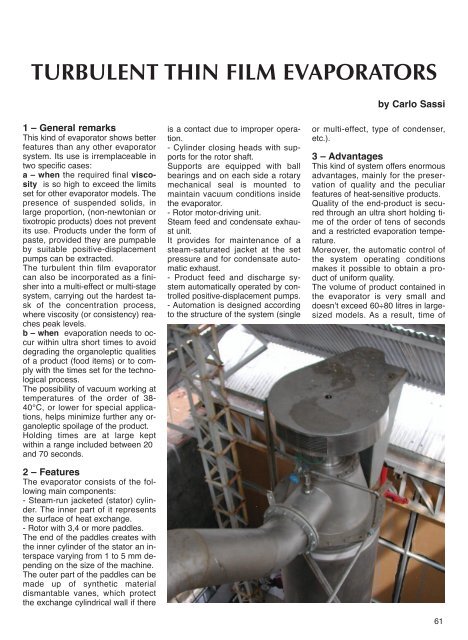Create successful ePaper yourself
Turn your PDF publications into a flip-book with our unique Google optimized e-Paper software.
TURBULENT THIN FILM EVAPORATORS<br />
1 – General remarks<br />
This kind of evaporator shows better<br />
features than any other evaporator<br />
system. Its use is irremplaceable in<br />
two specific cases:<br />
a – when the required final viscosity<br />
is so high to exceed the limits<br />
set for other evaporator models. The<br />
presence of suspended solids, in<br />
large proportion, (non-newtonian or<br />
tixotropic products) does not prevent<br />
its use. Products under the form of<br />
paste, provided they are pumpable<br />
by suitable positive-displacement<br />
pumps can be extracted.<br />
The turbulent thin film evaporator<br />
can also be incorporated as a finisher<br />
into a multi-effect or multi-stage<br />
system, carrying out the hardest task<br />
of the concentration process,<br />
where viscosity (or consistency) reaches<br />
peak levels.<br />
b – when evaporation needs to occur<br />
within ultra short times to avoid<br />
degrading the organoleptic qualities<br />
of a product (food items) or to comply<br />
with the times set for the technological<br />
process.<br />
The possibility of vacuum working at<br />
temperatures of the order of 38-<br />
40°C, or lower for special applications,<br />
helps minimize further any organoleptic<br />
spoilage of the product.<br />
Holding times are at large kept<br />
within a range included between 20<br />
and 70 seconds.<br />
2 – Features<br />
The evaporator consists of the following<br />
main components:<br />
- Steam-run jacketed (stator) cylinder.<br />
The inner part of it represents<br />
the surface of heat exchange.<br />
- Rotor with 3,4 or more paddles.<br />
The end of the paddles creates with<br />
the inner cylinder of the stator an interspace<br />
varying from 1 to 5 mm depending<br />
on the size of the machine.<br />
The outer part of the paddles can be<br />
made up of synthetic material<br />
dismantable vanes, which protect<br />
the exchange cylindrical wall if there<br />
is a contact due to improper operation.<br />
- Cylinder closing heads with supports<br />
for the rotor shaft.<br />
Supports are equipped with ball<br />
bearings and on each side a rotary<br />
mechanical seal is mounted to<br />
maintain vacuum conditions inside<br />
the evaporator.<br />
- Rotor motor-driving unit.<br />
Steam feed and condensate exhaust<br />
unit.<br />
It provides for maintenance of a<br />
steam-saturated jacket at the set<br />
pressure and for condensate automatic<br />
exhaust.<br />
- Product feed and discharge system<br />
automatically operated by controlled<br />
positive-displacement pumps.<br />
- Automation is designed according<br />
to the structure of the system (single<br />
by Carlo Sassi<br />
or multi-effect, type of condenser,<br />
etc.).<br />
3 – Advantages<br />
This kind of system offers enormous<br />
advantages, mainly for the preservation<br />
of quality and the peculiar<br />
features of heat-sensitive products.<br />
Quality of the end-product is secured<br />
through an ultra short holding time<br />
of the order of tens of seconds<br />
and a restricted evaporation temperature.<br />
Moreover, the automatic control of<br />
the system operating conditions<br />
makes it possible to obtain a product<br />
of uniform quality.<br />
The volume of product contained in<br />
the evaporator is very small and<br />
doesn’t exceed 60÷80 litres in largesized<br />
models. As a result, time of<br />
61




